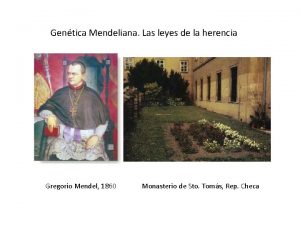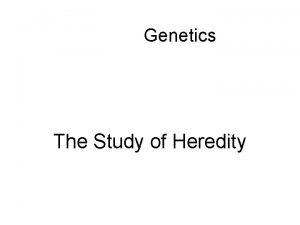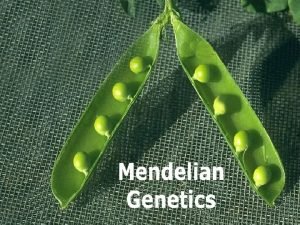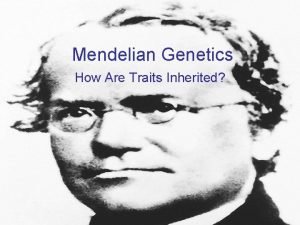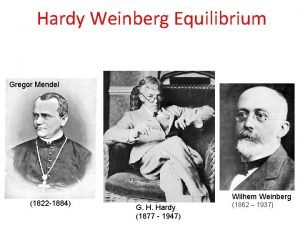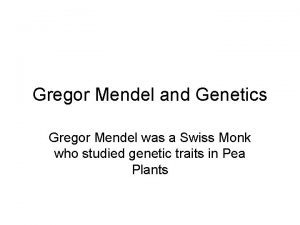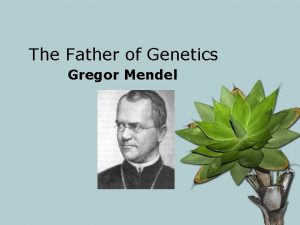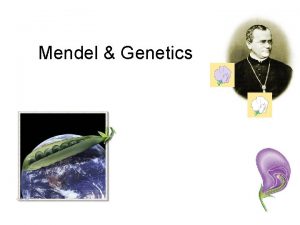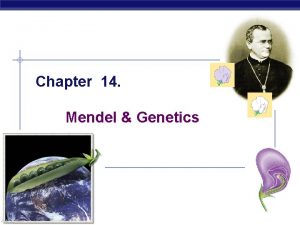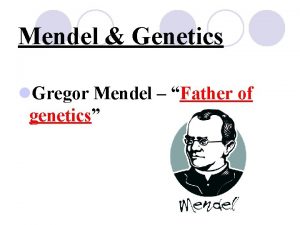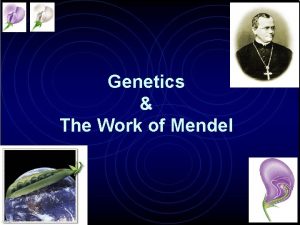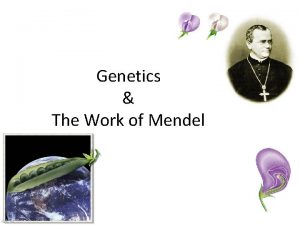Genetics Work of Gregor Mendel Genetics is the















- Slides: 15

Genetics

Work of Gregor Mendel • Genetics is the scientific study of heredity. • Gregor Mendel was an Austrian monk. His work was important to the understanding of heredity. • Mendel carried out his work with ordinary garden peas.

Work of Gregor Mendel • Mendel knew that – the male part of each flower produces pollen, (containing sperm). – the female part of the flower produces egg cells.

Work of Gregor Mendel • During sexual reproduction, sperm and egg cells join in a process called fertilization. • Fertilization produces a new cell. • Pea flowers are self-pollinating.

Work of Gregor Mendel • Mendel had true-breeding pea plants that, if allowed to self-pollinate, would produce offspring identical to themselves. Cross-pollination Mendel was able to produce seeds that had two different parents.

Work of Gregor Mendel • Genes and Dominance – A trait is a specific characteristic that varies from one individual to another. • Mendel studied seven pea plant traits, each with two contrasting characters. • He crossed plants with each of the seven contrasting characters and studied their offspring.

• Each original pair of plants is the P (parental) generation. • The offspring are called the F 1, or “first filial, ” generation. • The offspring of crosses between parents with different traits are called hybrids. Mendel’s F 1 Crosses on Pea Plants

Work of Gregor Mendel • Mendel's first conclusion – biological inheritance is determined by factors that are passed from one generation to the next • Today, scientists call the factors that determine traits genes.

Work of Gregor Mendel • Each of the traits Mendel studied was controlled by one gene that occurred in two contrasting forms that produced different characters for each trait. – The different forms of a gene are called alleles. • Mendel’s second conclusion – principle of dominance – some alleles are dominant and others are recessive

Work of Gregor Mendel • Segregation – Mendel crossed the F 1 generation with itself to produce the F 2 (second filial) generation. – The traits controlled by recessive alleles reappeared in one fourth of the F 2 plants.

Work of Gregor Mendel • The reappearance of the trait controlled by the recessive allele indicated that at some point the allele for shortness had been separated, or segregated, from the allele for tallness.

Work of Gregor Mendel • Mendel suggested that the alleles for tallness and shortness in the F 1 plants segregated from each other during the formation of the sex cells, or gametes.

Knowledge Check With which organism did Mendel work? What is meant by self-pollinating? What is cross pollination?

Knowledge Check What are genes? What are alleles? What is the principle of dominance?

Knowledge Check What is meant by segregation? What are gametes? When have we discussed gametes before?
 Mendel monk
Mendel monk Chapter 11 biology review answers
Chapter 11 biology review answers How did gregor mendel contribute to genetics
How did gregor mendel contribute to genetics Chapter 11 the work of gregor mendel
Chapter 11 the work of gregor mendel Section 11.1 the work of gregor mendel
Section 11.1 the work of gregor mendel Chapter 12 lesson 1 the work of gregor mendel
Chapter 12 lesson 1 the work of gregor mendel Chapter 12 lesson 1 the work of gregor mendel
Chapter 12 lesson 1 the work of gregor mendel Gregor mendel herencia
Gregor mendel herencia Y chromosome traits
Y chromosome traits Gregor mendel
Gregor mendel Austrian monk gregor mendel
Austrian monk gregor mendel Gregor mendel laws
Gregor mendel laws Gregor mendel
Gregor mendel Tesztelő keresztezés
Tesztelő keresztezés Gregor mendel chart
Gregor mendel chart 35 +0 2+1per10
35 +0 2+1per10







